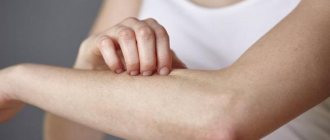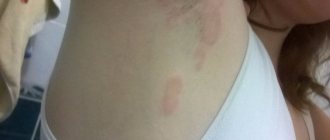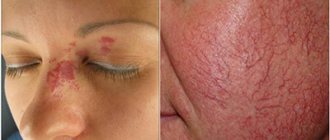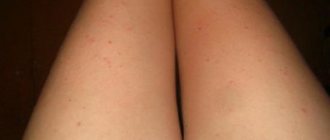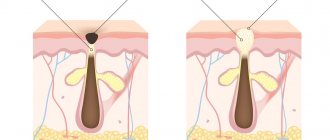- Pimples around the navel: causes
- Bacterial infection and acne on the navel
- Scabies and itchy pimples in the navel area
- Psoriasis and acne around the navel
- Allergies and acne below or near the navel
- Poor hygiene
- Pregnancy
- Pimple in the navel in an adult, treatment tips
Belly rashes and pimples around the navel area are most often caused by the development of infections and allergic skin reactions. But sometimes they can be caused by certain autoimmune diseases such as psoriasis. A rash around the navel should be treated properly through a prescribed course of treatment by a doctor to get rid of the infection or allergy. causing such a disease.
But you can also try some home remedies to get rid of this problem along with the treatment prescribed by your doctor.
In addition to the appearance of navel pimples, inflammation can be accompanied by other symptoms such as pain, itching, severe redness, etc. So, let's discuss all the problems and symptoms associated with navel pimples, their causes and treatments that can alleviate the problem and remove rashes located in this part of the abdomen.
Pimples around the navel: causes
There are many different causes of acne rash around the belly, ranging from mild allergies to hormonal disorders. Let's take a closer look at these causes of rash around the belly button.
Yeast infection on belly
Causes of yeast infection on the stomach:
The skin of the abdomen is more prone to excessive sweating when exerting itself, under the influence of synthetic clothing or in hot weather. This hot, humid and dark environment promotes the growth of yeast infections.
The yeast infection itself that causes the rash around the belly button is called a candida infection. It can also affect other areas such as the armpits, folds under the breasts, the mouth or oral cavity, and the vagina.
Symptoms of a yeast infection around the belly button:
Candida causes the development of red or pink rashes. These rashes are usually scaly and different from regular pimples. These red rashes may have yellow crusts on top of them.
Like many other fungi, this belly button candida infection is very itchy and painful at times. If you scratch or scratch the rash, it may bleed and may even have a foul odor from the rash.
Diagnostics:
A belly button rash caused by candida is identified through a physical examination by a dermatologist. But sometimes your doctor may take swabs from the belly button and send them for microscopic examination to make a more definitive diagnosis.
Treatment for yeast infection and pimples around the belly button:
A yeast infection on the belly button or candida fungus is treated with antifungal medications. Your dermatologist may prescribe you some antifungal creams such as clotrimazole for topical use and treatment of acne. If the infection is severe enough, your doctor may also suggest you take fluconazole tablets orally.
Salicylic-zinc paste for acne in the navel area!
Principles of treatment
Pregnancy significantly complicates the treatment of rashes, as it limits the choice of medications. Therefore, other methods of combating the disease are used. Stomach allergies are significantly reduced or disappear altogether after eliminating the allergen itself. Antihistamines are prescribed (Eden, Alerzin, Fenistil, Loratadine).
All pregnant women are recommended to choose natural, moisturizing skin creams. Often an allergy on the stomach manifests itself in stretch mark cream. A small correction of the diet helps significantly: it is recommended to give up coffee, tea, and juices. You need to eat foods high in pectin and fiber.
If you are concerned about eczema on the abdomen, severe itching and redness of the skin, you can use various compresses and rubs. Soda solution helps a lot. During treatment, it is important to monitor your own hygiene and take contrast showers more often. You should not expose yourself to stress, it does not contribute to recovery.
The rash in men is infectious in nature. The appearance of small bumps without itching, but grayish-red in color, indicates the development of a sexually transmitted infection. This is how gonorrhea and syphilis manifest themselves. Neoplasms associated with STDs are different. It all depends on the nature of the infection and the stage of the process.
The rash can be caused by eczema and psoriasis. Such chronic illnesses appear as huge red spots that become covered with scabs, causing severe irritation. With herpes, a red rash with bloody contents appears on the stomach. Bubbles are located on the stomach, thighs or back of the patient. The appearance of watery blisters indicates an allergic etiology of the disease.
Bacterial infection and acne on the navel
Poll: When did your acne appear? (Number of votes: 4295)
I've been suffering all my life
It's been a couple of years now
About a few months
Recently
To vote, click on the desired answer. results
Causes of bacterial navel infection
The belly button area is susceptible to many types of infections, including fungal and bacterial infections. If you have wounds on your belly button due to cuts, surgeries such as laparoscopy, or belly button piercings, you are prone to developing a bacterial belly button infection.
If you have a belly button yeast infection with candida and you scratch a lot, this will create open sores that will develop secondary bacterial infections. If you touch your belly button with infected or dirty hands or expose your skin to the contact of a dirty T-shirt or shirt, this will further worsen your belly button. problem The most common bacteria that cause infections in the navel area are staphylococcus and streptococcus bacteria.
Symptoms
They will cause symptoms such as redness or red bumps and a red rash across the abdomen. These rashes will also be itchy, similar to a yeast infection. In severe cases, the rash on the abdomen tends to be painful and produces a foul odor that appears yellow or green. If the infection is severe and can lead to complications such as an abscess or even sepsis.
Diagnostics
Diagnosis of umbilical cord infection is mainly done by your doctor by examining the rash around the belly button, but sometimes he may need to send you for certain tests to decide whether antibiotics are needed to treat such bacteria.
Treatment
Your doctor will prescribe antibiotics to treat an infection caused by bacteria around your belly button. If the infection is severe, you will need to take oral antibiotics. If the infection is more severe, it may even need to be treated with intravenous antibiotics.
Herpes on the stomach and navel: causes, treatment
Herpes on the stomach most often appears in the spring, when the immune system is weak. Surely most had chickenpox or chickenpox in childhood. Consider this to be your first encounter with the dangerous herpes virus. After all, childhood chickenpox usually goes away quickly and without complications. But the creeping disease virus remains “live” in the nervous tissues of various organs forever.
How to recognize the disease?
First, let us recall the causes of the disease. One of the main ones is reduced immunity.
But related sources can also provoke:
- exacerbation of other infections;
- excessive enthusiasm for diets;
- nervous tension;
- hypothermia.
Most often, inflammation in the abdomen and around the navel begins with cold weather or early spring. It is then that a person feels a lack of vitamins and amino acids.
This creates favorable conditions for the onset of the inflammatory process. The disease is often characteristic of older people due to the weak protective forces of the organ systems.
Vivid symptoms of herpes are initially preceded by itching and pain in the area where the disease will develop. After a few days, typical signs of a viral disease appear.
- Redness of the skin under the lower rib and around the navel. In this case, the patient is bothered by severe, incessant pain. A slight increase in temperature, general weakness, and dizziness are possible. The patient may be irritable and overly emotional. This is explained by the fact that the virus lives in nerve tissue and is distributed throughout all nerves.
- After two or three days, many spots appear on the skin, which differ in size, color and structure. Often such spots can merge with each other, forming a characteristic “belt” on the surface of the abdomen and on the navel.
- The rashes fill with watery fluid and create a large scattering of blisters. Under no circumstances should blisters be torn, touched with fingers, or pierced. After ten days, if there is drug treatment, the blisters will gradually begin to shrink, dry out and become covered with a keratinized crust.
After complete recovery in the area of the inflammatory process, the skin may be darker in color, remaining that way for a long time.
What are the causes of the disease in expectant mothers? During pregnancy, metabolism changes and the immune system is more susceptible to various infections. Therefore, the risk of infectious inflammation on the surface of the abdominal cavity and navel increases. The disease does not depend on the period of pregnancy.
We list the main signs of the disease:
- usually the rash occurs in the navel area and soon quickly spreads to the surface of the abdominal cavity;
- the onset of the inflammatory process is accompanied by severe irritation at the sites of the disease and scratching;
- after a short period of time, red-pink spots about five millimeters in size appear on the navel and abdomen. Soon, instead of spots, blisters filled with white liquid form;
- additional symptoms are possible: weakness, fever, severe pain.
We suggest you read: After removal, the mole appeared again
Often expectant mothers are concerned about the question of whether herpes is dangerous during pregnancy.
During the period of gestation of the unborn baby, the insidious virus first enters the blood and then the placenta of the fetus. Therefore, a virus during pregnancy can lead to complications for the unborn child.
Complications during pregnancy depend on when the infection entered the woman's body. Gynecologists emphasize that in the early trimesters of pregnancy, more severe consequences are possible for both mother and baby. The biggest threat is the first thirteen weeks of pregnancy. At this stage, herpes on the abdominal cavity and navel can negatively affect the health of the unborn child and even provoke a miscarriage.
Of course, it is important to know what effective methods exist to treat the disease. Treatment of herpes during pregnancy depends on the general condition of the woman. Usually, the gynecologist recommends antiviral drugs and immunity-boosting drugs to the expectant mother.
Scabies and itchy pimples in the navel area
Causes of scabies
Scabies is caused by a certain type of mite that burrows into the skin and lays eggs. They are highly contagious and spread from one person to another by touching or using contaminated clothing such as towels, etc.
Symptoms of scabies
Itchy pimples develop red rashes or bumps on the skin, mainly on areas such as the wrists, arms, ankles, buttocks, waist or navel, armpits, etc. These red bumps tend to itch for quite a long time.
Diagnostics
Scabies is diagnosed by your doctor through a physical examination. The doctor may also take a sample of skin tissue from the area of the rash to confirm the presence of mites.
Treatment
Scabies needs to be treated extensively to prevent the infection from spreading. It can be treated with many anti-scabies lotions and soaps that contain ingredients like permethrin, benzyl benzoate, lindane, sulfur, etc.
Causes of redness around and inside the navel
Omphalitis most often occurs in babies in the first weeks of life. The disease is caused by an infection of the umbilical wound. This is manifested by redness of the skin in the circumference, swelling, purulent discharge, fever and abdominal pain.
The immediate cause of hyperemia of the skin around and inside the umbilical fossa is infection. These can be bacteria (usually staphylococcus, streptococcus, Pseudomonas aeruginosa/Escherichia coli) or fungi.
But for its penetration into tissues, certain conditions are required:
- Fistula
. As a rule, this is a congenital pathology that occurs against the background of an open urinary/intestinal duct. In this case, intestinal contents or urine are released through the canal; - Acquired fistula
. This is formed due to inflammation of the anterior abdominal wall, which provokes the opening of a purulent abscess; - Anatomical features. If the skin umbilical canal is deeply retracted/excessively narrow, keratinized cells and sebum accumulate in it. If you do not follow the rules of personal hygiene, there is a high probability of infection and further inflammation;
- Wound
. Improper wound care also increases the risk of infection. Any damage to the skin is an open gate for infections. For example, people who have had a navel piercing but do not properly care for the piercing site often suffer.
Redness of the navel in adults and other symptoms of omphalitis
Main signs: redness, swelling and serous discharge inside the fossa. When the inflammatory process is complicated, the latter include impurities of pus/blood. The general condition of a person also worsens due to intoxication. The temperature stays between 38-39°C. Inflamed skin becomes more protruding and hot to the touch, especially at the site of inflammation. The wound itself becomes covered with a crust, under which purulent masses accumulate.
The infection can spread to surrounding, still healthy tissues, as well as blood vessels. Against this background, phlebitis or arteritis develops - the most dangerous variant of the disease.
Forms of the disease
There are three forms of the disease, each of which is a consequence of the previous one:
Redness of the navel in newborns
What other problems may arise with the navel in babies in the first weeks of life:
- The wound is bleeding, the skin is red or blue - symptoms of injury. This can happen due to careless hygienic manipulations or when putting on clothes/diapers, turning the baby over, etc. It is necessary to treat the stomach with peroxide and lubricate it with an antiseptic solution. If symptoms persist, consult a doctor;
- Redness and weeping - the presence of a foreign body in the navel. It is necessary to visit a surgeon to carry out the appropriate manipulations;
- Redness without inflammation is a skin injury. This is often observed in babies 6-10 months old - they are actively exploring their body. Another reason is allergies, food or contact. But in this case, rashes will also be observed on other parts of the body.
What to do?
Regardless of the indirect cause of inflammation, immediate action must be taken. Otherwise, the infection will spread. It is necessary to visit a surgeon and, if necessary, submit the discharge for bacteriological analysis.
Usually the disease is treated with conservative methods. Radical (surgical) treatment is used only in the presence of a fistula. Timely initiation of therapy guarantees quick relief from the disease and the elimination of complications.
Treatment of a simple form
Every day you need to wash your navel with antiseptic agents: hydrogen peroxide or furatsilin solution. It also needs to be lubricated with 70% alcohol, 1% brilliant green or 5% potassium permanganate. Supplement local treatment with ointments: tetracycline or syntomycin 1%.
If granulations appear, the wound is washed with 3% hydrogen peroxide, and they are cauterized with lapis (10% silver nitrate solution). If necessary, the doctor will prescribe ultraviolet irradiation.
Treatment of the other two forms
If in the first case you can get by with outpatient treatment, then these two forms require a hospital stay.
Since the course of the disease in this case is severe, and the symptoms of intoxication are pronounced, local therapy with antibiotics is carried out. A broad spectrum of drugs is prescribed, taking into account the sensitivity of the identified microbes to them. To do this, carry out the above-mentioned bacterial analysis of purulent discharge.
Almost always, with purulent inflammation of the navel, it is necessary to resort to radical measures - surgical. To prevent the spread of infection to nearby tissues and organs, the wound is drained (cleaned) and the pus is removed through a probe.
In the presence of fistulas, there is only one way out - excision of the canals and suturing of defects in the walls of the bladder/intestines.
If the navel area becomes red, treatment with antiseptics is required. If pus appears, you should consult a doctor to prescribe antibacterial drugs. In a newborn, the umbilical wound heals in 1-3 weeks. If this does not happen, consultation with a pediatrician and possibly treatment is required.
Appearance of a rash on the abdomen
is always an alarming sign of a malfunction of the body.
This rash can look different, depending on the reasons for its appearance. It appears in both children and adults (see “Rash on the body of an adult”). In appearance, the rash appears:
- in the form of small scattered spots that differ in color and texture from healthy skin;
- in the form of large spots merging with each other;
- Based on the color of the rash, it is divided into those that discolor the skin and those that enhance its color: the rash can appear in the form of white, pink and red spots;
- in structure it can be similar to bubbles filled with liquid, keratinized skin cells, white or light gray scales, scabs, etc.;
- the rash may differ in temperature from surrounding tissue.
Psoriasis and acne around the navel
Causes
The exact cause of psoriasis is not yet known, but many factors believed to cause psoriasis include genetics, autoimmunity, infections, side effects of antibiotic medications, and skin trauma.
Symptoms
Psoriasis is a skin disease in which skin cells divide at a rate much faster than normal skin cells. The newly divided cells enter the top layer of the skin, forming red patches covered with silvery scales.
They can affect any part of the body, including the navel, scalp, torso, arms, legs, etc. Also, these red spots and pimples are quite itchy and itchy.
Diagnostics
Psoriasis can be easily identified by your doctor due to the presence of silvery-white scales over red patches. These scratches also tend to bleed when scratched. Doctors can identify psoriasis through some other sophisticated tests and tests, if necessary.
Treatment
Psoriasis rashes that cause pimples near the belly button are treated using many types of topical creams or ointments that contain salicylic acid, coal tar, steroids, or calcipotriene. You may also be prescribed retinoids to treat this condition.
Treatment of different forms of dermatomycosis
Fungal skin lesions are difficult to treat and often recur. The disease may return, so the prescribed courses of medications must be completed. After diagnosis, drugs that are most effective against a specific pathogen are selected. When infected with a rare type of fungus, the most popular remedies may be ineffective.
When determining treatment methods, the following are also taken into account:
- degree and area of damage;
- patient's age;
- duration of infection;
- health status.
All these factors allow you to choose the best treatment options. To destroy the fungus, it is necessary to use antifungal drugs. They are of local and general action. The pharmaceutical industry produces about 200 types of drugs against the pathogen.
The initial stages of the disease can be cured with local remedies; they are produced in the form of ointments, gels and sprays. For severe and prolonged skin damage, preparations for internal use are used.
A necessary part of the treatment is treating the affected areas with antiseptics - potassium permanganate, furatsilin, boric acid.
Products used:
Physiotherapy is often prescribed. The procedures help enhance metabolic processes in tissues and speed up recovery.
Shown:
- laser treatment:
- magnetic therapy;
- electrophoresis.
Treatment ends after negative control tests.
Simultaneously with treatment, it is necessary to treat clothing with daily washing and airing. It is necessary to disinfect shoes, towels, household items (washcloths, combs, etc.) so as not to spread the infection to other parts of the body. It is necessary to allocate individual items for the patient to prevent infection of other family members.
Rashes due to mycosis can spread from the abdomen to other parts of the body. Infection of the skin of the feet and nails with fungus is especially common. Onychomycosis is a nail infection that requires months of treatment.
Abdominal rashes may go away quickly on their own or require long-term therapy. Timely diagnosis will help avoid serious damage to the deep layers of the skin. To prevent skin problems from occurring, you need to monitor your diet, follow hygiene rules and strengthen your immune system.
Redness of the navel may indicate inflammation - omphalitis. This disease, which is accompanied by inflammation of the skin and subcutaneous tissue in this area, is quite rare. Almost everyone knows about navel problems in newborns, but similar things can happen to adults.
Allergies and acne below or near the navel
Many types of allergies can lead to a rash on your abdomen below or near your belly button. You may be allergic to new clothes made of non-breathable synthetic fabric, a new soap or detergent that was used to wash your clothes, or even because of a belly button piercing, etc. .
Belly button pimples and rashes like these should be treated by your healthcare provider. You need to take antihistamines. If the rash is severe, you may even need antihistamine injections to completely cure the allergy.
Rules of care and prevention
To reduce the number of factors influencing the appearance of a rash in the baby’s life, parents must strictly follow preventive measures:
- bathe the baby daily with soap and dry with a clean towel;
- walk more in the air so that the child receives vitamin D from the sun's rays (with the exception of midday in the hot season);
- carry out hardening procedures;
- regularly examine your child’s skin;
- monitor heat exchange and create the optimal temperature in the room;
- eliminate possible allergens from food and household items;
- strictly observe the rules of hygiene.
If a rash does appear, do not rush to lubricate it with brilliant green or iodine, although such a measure may subsequently be prescribed by a doctor. It helps reduce itching and disinfects the affected area of the skin.
We suggest you read: How to take trichopolum for acne
To diagnose the disease, a blood and urine test will be taken, and, if necessary, an analysis to identify the allergen. The treatment prescribed by the pediatrician will depend on the cause of the disease:
- for infectious and bacterial infections - antibiotics and antiviral drugs;
- for fungal infections - antifungal agents;
- for allergies - antihistamines;
- for scabies and other parasitic diseases - comprehensive treatment to eliminate the cause.
If the cause of the rash is insufficient hygiene and improper care of the child, you should consult a doctor about why the rash occurs on the stomach or back. Perhaps the child is often sick or bathes little, comes into contact with insects, animals, and rodents. In this case, it is necessary to disinfect the room and continue to follow the pediatrician’s recommendations.
Attentive and caring parents are largely the guarantee that the child will not get sick, since all preventive measures will be taken in advance. If a rash does appear on the body, do not try to determine its nature on your own: you can only harm the baby. Show it to your pediatrician, who will prescribe appropriate treatment. And be healthy!
Pregnancy
Pregnancy is a wonderful time in a woman's life But it also comes with many changes in a woman's body that can cause discomfort and even acne in the belly button or face. During pregnancy, the abdomen expands, which causes the skin over the abdomen to stretch.
This causes the belly button or belly to become very itchy. If a pregnant woman scratches or constantly scratches the area, sores develop, leading to the growth of bacteria and fungi that cause a rash on the belly.
To avoid this problem, pregnant women should avoid dry belly at all costs. Try to moisturize your belly with a good moisturizer to avoid developing this rash around your belly button.
Erythromycin antibiotic ointment for acne!
Causes of dermatitis
External reasons
Skin manifestations on the abdomen in the form of irritation, rashes of various types appear with prolonged squeezing, friction, as well as exposure to chemicals on the body. This could be tight clothing, or a man wearing a belt buckle that constantly puts pressure on his stomach. Long-term exposure to high temperatures and sweat contribute to the appearance of microtraumas of the skin and the attachment of infectious pathogens.
Other causes of abdominal rashes:
- different types of radiation - x-ray, ultraviolet;
- high and low temperatures;
- dust and pollen;
- components and household chemicals from clothes.
Damaged epidermis is easily infected with fungus, bacteria, viruses, and scabies mites. Irritation that occurs in the folds of the skin often becomes the site of infection and leads to mycosis, scabies, and herpetic infections.
Internal factors
A rash on the abdomen may be a consequence of internal problems of the body associated with metabolic processes and other diseases.
She is called:
- unbalanced diet;
- hypo- and vitamin deficiency;
- metabolic disorders;
- taking medications;
- neuropsychiatric diseases;
- autointoxication, accompanied by dryness of the skin.
Most often, a rash with itching and irritation of the skin in children is caused by improper feeding and emerging.
In case of dermatomycosis, scrapings from the skin are examined under a microscope to determine the type of fungus. The luminescent method is also used.
Skin diseases are caused by a whole group of pathogens:
- microsporum;
- trichophyton;
- candida.
For effective treatment, it is often necessary to know the exact type of pathogen in order to select the right antibiotic.
Pimple in the navel in an adult, treatment tips
We have covered all the possible causes of pimples and rashes around the belly button in adults and children. Now let's learn some tips and treatments to keep the rashes around the belly button under control.
Good hygiene:
Since belly pimples can be caused by poor hygiene, you need to maintain good hygiene to get rid of the rash Try to wash or clean your belly button area at least twice a day You can clean your belly button with a tissue ball immersed in warm salt water You can prepare salt water by dissolving 1 - 2 teaspoons of salt in a cup of warm water.
About a super powerful home method for washing pimples in the navel area with sea salt solution!
You can also use antibacterial soap to clean this belly area. Then, after cleaning the rash around your belly button, make the area completely dry without wearing a T-shirt over the wet area.
Warm compress
A pimple rash on your belly button can make you feel pain. You can get relief from the pain by applying a warm compress to the rash. Just dip a clean washcloth in warm water and then squeeze out the excess water. Apply this warm washcloth to the rash on your stomach and massage it a little to get relief.
White vinegar
White vinegar is indeed very effective in getting rid of infections and pimples in the belly button Take a spoon of white vinegar and mix it with 2 spoons of water Dip a cotton ball in this white vinegar mixture and apply it on the rash on your stomach Wait for 5 to 10 minutes then clean your belly button with warm water .
Cautions and Instructions for Using Apple Cider Vinegar for Acne!
Fungal diseases
Sometimes redness and itching in the navel in an adult are caused by a fungal infection. This problem is typical for overweight people due to sweating. A risk factor is neglect of hygiene, especially changing bed linen.
The danger of the fungus is the growth of swelling, which provokes the occurrence of inflammatory omphalitis. The formation of the disease is indicated by sulfur or purulent discharge in the umbilical cavity.
Inflammation
The most dangerous problem among the causes of itching around the navel in women is omphalitis. Most often, the inflammatory disease occurs in children, before the umbilical cord heals, but can also occur in adulthood. The main provoking factor in adults is the entry of staphylococcus into the wound on the umbilical ring or umbilical cord.
Omphalitis can be diagnosed visually. This red spot with pimples itches and swells, accompanied by dry discharge. In advanced stages, pus is mixed with the blood and the temperature rises.
Attention! If inflammation of the umbilical cord grows or a crust of serous or purulent discharge appears, you should immediately consult a specialist.
Having found out why the inside of the navel itches, the doctor will make a diagnosis. However, only a pediatrician or surgeon can determine the cause and prescribe treatment after diagnostic procedures. This disease is infectious and is caused by lack of treatment of the umbilical wound.
Scabies mite
Umbilical hernia
If the navel itches and turns red, and coughing and sneezing are accompanied by acute pain, there may be a pathology of the umbilical ring. A hernia is a defect in the abdominal wall and an unpleasant reason why women's navel itches on the outside. Treatment is massage and umbilical patch.
Attention! Umbilical hernias resolve without medical intervention in children under 5 years of age. At an older age, you need to see a therapist.
When a woman's belly button itches
In certain situations, itching in and around the navel occurs due to natural irritation. These reasons include:
- piercing;
- tattoo;
- pregnancy.
Temporary scabies in such cases does not require treatment and goes away on its own. It is enough to make sure that there are no other problems described in the article. Only if the navel itches after a puncture with the formation of suppuration or inflammation does it need to be thoroughly disinfected. Considering the navel piercing and why it itches, we can say that the reason is that the procedure was not sterile enough.
To relieve itching, you can use folk remedies to reduce skin sensitivity. In addition to regular showers and changing bed linen, you can use herbal infusions. Among them:
- calendula;
- aloe;
- chamomile;
- tea tree;
- turmeric;
- olive oil.
These products simultaneously help in cleansing and soothing the skin internally. Severe itching around the navel usually goes away, but if it intensifies, it is possible. Therefore, it is important to use proven medications and monitor your condition.
You can often find out about problems in the body by the condition of the skin. Red or light spots, blisters, itching and flaking on the abdomen can be symptoms not only of skin diseases, but also of general pathologies.
By the type and nature of the rashes, a specialist can understand what problems caused them.
Pimples on the abdomen in adults and children: treatment of rashes in the lower abdomen in women
Pustular formations periodically appear on different parts of the body. Pimples are least likely to appear on the stomach, since there are not many sebaceous glands on it.
An unpleasant manifestation is caused by various pathological processes. The cause can be preliminarily determined by the nature of the rash and additional symptoms. But a doctor should make a diagnosis and prescribe treatment.
Pimples on the stomach in men and women: causes
Abdominal rashes appear in both men and women at any age. Acne is often associated with hormonal imbalance. If there are malfunctions, the functions of the sebaceous glands are disrupted, sebum production increases, and the skin’s ability to resist the negative effects of bacteria deteriorates.
Pimples can be small and numerous, red or with pus.
The causes of acne are determined by the nature of acne, which are grouped into several categories:
- skin diseases;
- allergic reaction to medications, products;
- endocrine pathologies;
- infectious and viral diseases;
- insect bites.
In women, an unpleasant symptom may be associated with pregnancy or menopause.
What do pimples on your stomach mean?
The appearance of pustular elements indicates health problems. The dermis consists of many pores, and when they become clogged with sebum, bacteria, dead epidermal cells or dirt, acne appears.
A healthy body regulates the amount of secretion secreted by the sebaceous glands, resists bacteria, and cleanses itself. In the presence of diseases, the functions of the epidermis deteriorate.
Red pimples on the stomach
Red color indicates skin irritation. The scarlet rash is usually accompanied by itching. Often the cause of symptoms is a lack of proper hygiene and the use of shared washcloths. In hot weather, bacteria accumulate in the navel area. Infrequent hygiene procedures contribute to the rapid growth of pathogens.
Various diseases can also act as provocateurs of symptoms:
- chicken pox - red formations spread throughout the body;
- allergy;
- helminthiases;
- scabies - rashes are localized in the umbilical area, on the inner thighs;
- follicular hyperkeratosis.
Reasons to consult a doctor include increased redness and high fever.
Small pimples on the stomach
Small rashes in dermatology are called papules.
As a rule, they are a clinical manifestation of the following diseases:
- Miliaria is characterized by multiple clear blisters or nodules.
- Atopic dermatitis is manifested by increased irritation and itching.
- Measles is a papular exanthema (dermal reaction to the action of a virus of the genus Morbillivirus).
- Insect bites are characterized by swelling in the areas of the rash and severe itching.
Papules may appear due to irritation. In such cases, they disappear on their own after 1-2 days.
Purulent acne on the stomach
Pustules are small pimples containing pus or fluid. They usually appear as white bumps surrounded by red skin. When in contact with clothing or fingers, painful sensations occur. With pustules, a slight increase in temperature and abnormal bowel movements (diarrhea) are often observed.
Pus is formed as a result of the ingress of pyogenic (pyogenic) microorganisms: staphylococci, streptococci, fungi. Pustules are characteristic of furunculosis. With the growth of staphylococcal microflora, a purulent-necrotic process develops in the hair follicle.
The appearance of pustules with infiltration may be due to hormonal imbalance. It is caused by changes in the body during adolescence, pregnancy or diseases of the endocrine system.
Rash in the lower abdomen in women
Women's skin is more sensitive and reacts quickly to negative factors. Most often, rashes are a reaction to an irritant. Synthetic fabrics and the use of cosmetics cause allergies. The appearance of small red blisters is often associated with hormonal imbalances caused by pregnancy and menopause.
But there are also more serious reasons for the occurrence of an unpleasant manifestation:
- skin diseases: psoriasis, scabies;
- herpes zoster;
- pityriasis rosea;
- fungal infections: rubrophytia, candidiasis;
- rubella;
- scarlet fever;
- inguinal athlete's foot.
Pustular elements can also occur with sexually transmitted infections.
Pimples on a child's stomach
A common cause of pimples in young children is lack of proper hygiene. Afraid of accidentally injuring the skin, young mothers do not wash their baby well. Constantly wearing diapers impairs air circulation; a humid environment favors the growth of bacteria that cause rashes.
In older children, the appearance of pustular elements is associated with allergies - the body’s reaction to the introduction of new foods and medications. The cause of the rash can be chickenpox, measles, rubella, and infectious diseases.
At the first unpleasant manifestations, the child should be immediately taken to the pediatrician. An unformed immune system is poorly resistant to negative factors. Delayed treatment can lead to complications.
What to do if red pimples appear on your stomach and itch?
If red, pustular or other pustular elements appear, there is no need to panic. Unpleasant manifestations on the skin are often not dangerous and go away on their own after 2-3 days.
It is necessary to review the diet, reduce the amount of protein foods consumed, and exclude red vegetables and fruits. They change their wardrobe, giving preference to things made of cotton and linen fabric.
Particular attention is paid to hygiene; the inflamed area is washed at least 5-6 times a day. soap is used with a minimum content of dyes and flavors.
If the itching intensifies or the rash spreads to neighboring areas, you should consult a doctor.
How to get rid of acne on the body?
Regardless of the clinical picture, it is possible to get rid of the unpleasant phenomenon only if the cause is identified and eliminated. It should be identified by a specialist.
Before diagnosis and treatment, the severity of the rash is reduced with the help of natural or pharmaceutical antiseptics. For itching, take antihistamines.
Taking vitamin complexes helps increase the body's immunity and resistance.
You cannot prescribe therapy yourself. A number of different diseases have a similar clinical picture. Incorrectly selected medications can complicate the situation.
Be sure to read:
What do pimples on the cheeks mean: folk signs
Drug treatment
If enhanced hygiene and diet changes do not relieve the problem, use medications:
- Benzoyl peroxide is present in many creams and gels for acne (Proderm, Desquam). The substance dries out acne and kills pathogenic flora.
- Products based on resorcinol (Adapalene, Differin) have antimicrobial and dermatotropic properties. Suppresses bacterial growth and stimulates regeneration.
- Ointments and creams based on dexpanthenol (Bepanten, Panthenol, Korneregel) relieve inflammation, absorb toxins and excess sebum.
- The use of preparations for external use containing sulfur (Sulfodecortem) helps soften the stratum corneum, which promotes deep cleansing. Ointments are effective for psoriasis and other dermatological diseases, and reduce allergies.
If necessary, the doctor prescribes antibiotics or antiviral drugs.
Traditional methods
To get rid of an unpleasant symptom, alternative methods are used:
- Nettle leaves (2 tablespoons) are poured with 1.5 cups of boiling water and left until cool. I drink a glass of the strained solution 2 times a day for a month.
- Burdock roots are ground in a blender. 1 tbsp. l. pour 0.5 liters of boiling water and cook for 10 minutes. The strained drink is taken 100 ml 2 times a day.
Traditional methods are used only after consultation with a specialist.
Preventing acne on the stomach
To avoid a rash, you must maintain hygiene, monitor your diet and take preventive measures:
- Wear loose clothing made from natural fabrics.
- Use hypoallergenic soap and gel.
- If you are prone to allergies, it is advisable to use tests to identify the allergen and eliminate contact with it.
- After traveling on public transport, wash your hands with soap or treat them with antibacterial wipes.
- Use barrier contraceptives during sexual intercourse.
Get an antiviral vaccination; it is better to prevent a disease than to treat it.
Conclusion
Rashes near the navel and groin do not cause aesthetic discomfort and often go unnoticed. An unpleasant phenomenon may be the result of a serious illness. Ignoring the problem can lead to serious consequences.
Source: https://Kataliya.ru/pryshhi/raspolozhenie/pryschiki-na-zhivote.html
